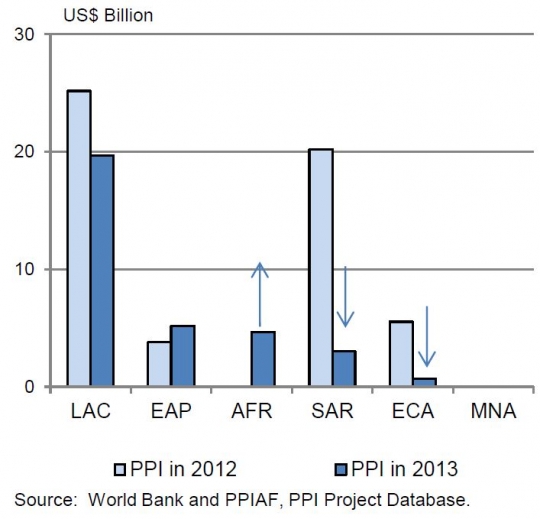Recent World Bank Data Reveal Worrying Trends in Transport
The World Bank’s Public-Private Partnership Group and Public-Private Infrastructure Advisory Facility report that total private participation in infrastructure (PPI) fell in the transportation sector in emerging markets by 39 percent to $33.2 billion in 2013, compared with 2012 levels.
In part, this reflects a broader trend – overall, PPI in all infrastructure sectors fell by 24 percent. The biggest drop was in South Asia, which saw PPI in transport fall from just over $20 billion in 2012 to approximately $3 billion in 2013, mostly because of significant decreases in India. Two other regions – Latin America & the Caribbean (LAC) and Eastern Europe and Central Asia (ECA) – also saw decreases. PPI in transport increased in East Asia and the Pacific (EAP) and Africa, but not by enough to offset decreases elsewhere.

2013 Transport PPIs by region
This is not good news for the world’s poor. Transportation is a critical component of development and growth, enabling people to access schools, hospitals and markets. It facilitates labor mobility and ensures that raw materials and finished goods get to customers. In rural areas, transportation systems provide an economic and social connection with the rest of the country. Within cities, good urban transportation is often the only form of transportation available to the poor. It also improves the flow of goods and services, reduces greenhouse gas emissions, and improves the overall quality of life.
Unfortunately, transportation systems are expensive to build, operate and maintain. And setting fares can be tricky: If they are affordable to the poor, they often aren’t enough to cover costs. And the costs can be enormous: The U.S. Department of Transportation reports that annual maintenance costs for highways and bridges alone could be as high as $86.3 billion per year. High cost combined with uncertain revenue adds substantially to the risks of financing transportation infrastructure.
This is why involving the private sector in infrastructure is proving invaluable. Well-structured public-private partnership transactions attract private operators with the funding, technical expertise and managerial skills to build and operate transportation infrastructure, including ports, roads, bridges and urban transportation systems. Transparent, competitive bidding ensures the lowest cost, which serves the public interest. And because private operators need to cover their costs, they have the incentives to work out optimal fare or fee structures – which may or may not include subsidies – with their government partners.